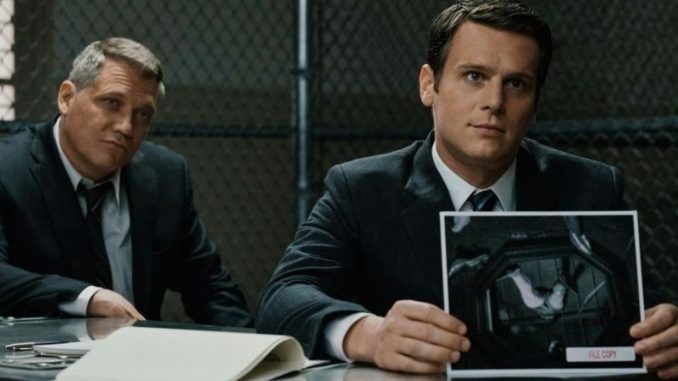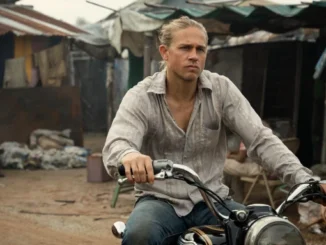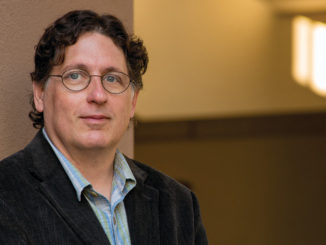
by Patrick Z. McGavin
In a world filled with police procedurals, Netflix’s “Mindhunter” has attracted a lot of attention.
Created by Joe Penhall, the series is a police procedural about two FBI special agents, Holden Ford (Jonathan Groff) and Bill Tench (Holt McCallany). It has attracted top-tier talent such as David Fincher, Carl Franklin (“One False Move”) and executive producer Charlize Theron.
The second season dropped last month on the streaming platform. The Australian-born editor Kirk Baxter, ACE, a two-time Academy Award-winner for Fincher’s “The Social Network” (2011) and “The Girl with the Dragon Tattoo” (2012), is the editor of four of the nine episodes.

In an exclusive interview, Baxter talked about serial killers, editing difficult material, and working with the notorious perfectionist Fincher.
You you have had a long and very successful creative collaboration with Fincher. How did you first meet?
Kirk Baxter: I got introduced to David through Angus Wall when Angus was editing “Zodiac” (2007). I got brought into helping out, so I met David when I was already cutting a scene for him. Things went well. I became a puppy that never left.
How you would describe your working methods?
Baxter: I try to rely on him as little as possible because I am familiar with what his days are like, especially during the shooting process. David is incredibly busy, and I like to get on with it.
We work through PIX [a workflow tool that allows production teams to securely share and review content], so I will put a lot of stuff up for him every day and it is the day’s PIX that we critique and do back and forth at his pace.
David is pretty good at being all-consuming. He will tend to get back to me immediately. I don’t really hit him with questions. I just hit him with work.
He shoots, I select, put something together and send it to him and I take the feedback kind of dryly. I don’t take anything from [it as] a personal affront. I just work until it is there, until we are happy with it. I am trying to outgrow the part where you loathe yourself until you like the scene. I am getting better, but I haven’t perfected it yet.
Wheat tends to happen is during the shooting process, the initial assembly is just misery. We all hate ourselves, hate the show, and then once it is beginning to take shape, there is more of a jovial atmosphere where you start to feel comfortable that things are working.
In Season 2, was there a conscious decision to take the work in different stylistic or formal directions?
Baxter: No. David might have had that conversation with the cinematographer Erik Messerschmidt, but certainly not with me. Again, rarely am I going to have a philosophical conversation about what we want to do. My communication with David is just by doing.
One of the primary themes the show examines are the psychological ramifications of working in this area of criminal justice. For the special agents, you can’t interact with monsters and not have it impact you. Is there a way you want to reflect that in the editing?
Baxter: It is the subject matter. I think what differentiates the show is that there is no real scene that exists outside the main characters outside of the BTK Killer (Sonny Valicenti). Nothing is essentially overdramatized. There is no bloodletting, unless the agents are there as it is occurring, which would be unrealistic because they are reactionary.
The closest they get to that is the psychological terror when you are sitting face to face with people that are capable of doing those things and trying to peel the onion a bit.
In Kent Jones’s documentary about the Truffaut/Hitchcock interviews, David Fincher talks about a lot about the influence of Hitchcock, especially how it impacted his cutting rhythms.
Baxter: He has never spoken to me about his Hitchcock influences. I was working a long time before I met David, and I do feel David taught me how to edit.
My taste in terms of how to put a scene together or what you want to get out of the scene and when you have content to put things down and stop fiddling with it is very much aligned with what his taste is.
The downside of that is that it makes it harder to watch other things. You are critical of everything. What you are trying to do is critique and critique and critique yourself. It is endurance.
David has a great way of covering. He has this silly reputation of doing a lot of takes, but it is not the same angle getting repeated a thousand times, it is coverage. So there is always somewhere to be in the scene. If you are doing a very dialogue-heavy piece, it is great to have the coverage there so you can be moving around.
That is the part I really enjoy. That is the math and the chess game, and how do you build up the importance of a moment by how you are framing it and how you skilled are at that moment in time. David helps with that by keeping everything locked down and quite precise about when the camera is going to move and not move. It’s the volume of angles that really differentiates how information is presented in David’s work.
I think the most engrossing and terrifying moment in the season is in Episode 2, the interview in the car between Tench and the young man who survived being shot by the BTK Killer. Could you talk about that sequence, especially as a microcosm of the show itself, a study of evil and pathology, but also an attempt to deal with those who get left in the ruins?
Baxter: That was a fascinating scene to do. David did not really speak to me too much about it. He talked about the coverage he would get. As I as going through those dailies, he covered how he would most things. The victim in the backseat had complete coverage on him. You could see his face, over the shoulder, profile through the window, I could have cut it to include him through the entire thing.
One of the last set ups was Tench in the front seat and the victim in the back seat out of focus, he has a bunch of takes of that all the way through. That was a peculiar set-up. It wasn’t normal coverage. When I saw that, I said, I got you. Here’s where we are going. It became obvious that should be the backbone of the scene.
The first thing I did was assemble it together, leaning on that shot as much as possible. Then I used the coverage of the kid, but just the moments when he was obscured, with his hands. The torment of presenting him in the same way that Tench gets him, which is to not see him, is to heighten the entire scene. This was not my idea. This was David’s intent. He covered it just so in the event that did not pull the audience all the way through, he could do it another way. It was absolutely that.
We popped outside one time through the window and he added some reflections to cover him there as well, so it continues to torment. David had the idea of adding train sound effects going through, just again to put you on edge and lean forward and really listen.
The way the scene was written, it was a very long scene in terms of dialogue. If we cut it in a traditional fashion of seeing people talk and seeing people connect when they look at each other, then it probably would have held the amount of dialogue that was originally intended.
With the constraints that we built, I was tasked with pulling out as much as possible. We took about maybe 40 seconds out of it. I moved everything I could in terms of information without making it break. I got it as lean as I possibly could, with that idea, let’s frustrate the audience but not bore them. When it was longer, it just sort of became insufferable.
The interview, or interrogation, is the one key structuring devices. It gets at the themes of power and control. Also in episode 2, Holden and Tech interview the Son of Sam. It’s riveting but also unnerving. Everything seems heightened because of the claustrophobia of the set-up, especially the restricted spaces between the agents and the Son of Sam.
Baxter: That is what it makes it fascinating. You have the whole build up where you think Holden is going to crap the bed, and Tench is getting in there in that room with him. It has a slow start, the first third Holden is kind of holding back. I tried to exploit that as much as we could by showing him stumbling a bit in the beginning and then getting back up to his old pace and then kind of cracking Son of Sam wide open.
It’s fun. It goes back to coverage. You are pinned into this small tiny space, but if you look at the amount of coverage we have and the number of angles available, we really move around inside that room and stretch whichever point you want to make. It moves very rapidly, but when you decide to emphasize a reaction, you show how Holden gets underneath Berkowitz’s skin by his delays in answering. They are terrific performances.

It was a challenging one to put together. It took me about two weeks to really get that thing honed and then a couple of days to perfect it with what we were trying to do.
Janet Malcom wrote a celebrated essay arguing that all journalists are basically con artists who fake empathy in order to gain the trust of their subjects. Do you think that’s what Holden and Bill do?
Baxter: I’d have to leave that to you, I think. I call Holden “Captain Earnest.” He believes what he is doing. He can be robotic on an emotional level of how he goes about doing it, and Tench is a little more aware of those around him and a bit more tenderized by the system.
Anna Tory, who plays Dr. Wendy Carr — we get more of her personal story this season. She is a cultural outsider, a woman in a male-dominated hierarchy. She is also an outsider because of her sexuality. I really like the build up, between the furtive glances to the flotation, with the bartender played by Lauren Glazier.
Baxter: I agree. I like those characters so much. When you are building those scenes, Wendy saying to Holden she is going to be there for him while she is checking out the barmaid is hilarious. I am laughing every time we are watching scene together.
Later, when I watched it at home, and see this as a whole, my intention was to have it play out in a more subtle space, which I was quite happy with. When I was making it, I am highly tuned into every little miniature thing everyone does. I enjoy that it wasn’t over the top.
It’s interesting because originally episode 1 and 2 were built as one big episode. That was our original intent. The first two episodes were one massive one, and then [Steven] Soderbergh gave David some notes, saying there was too much meat in the sandwich, try breaking it in half. We were going to do eight episodes, but we ended up doing nine. It was going to be a feature length episode at first, and he broke it into two. I think it worked out well.
You are also a co-producer on the show. What does that entail?
Baxter: I think it is so that Fincher is not isolated in the billion collective decisions it takes to put together nine hours of content. It is just helping out, not just the episodes I am credited with editing, but also streamline and steer the others to speed things up to date. If he has to do it all, then he doesn’t get any sleep.
How did you first develop an interest in editing?
Baxter: That would go back all the way to when I was 17. I did work experience at a production company in Australia that had a couple of stages in pretty much all departments: directing, cinematography, focus pullers, grips, gaffers. I did a little bit of everything. I got introduced to all departments, production and so forth. It was a lot like a film school. They also had editorial.
I found at a young age I was able to be making something in the field of editorial immediately. At the production level I was driving things. I could have worked my way through the system into becoming a cinematographer, or something along those lines, but it was a long road. The place where I was at was like an army, where first you were focus puller and then the operator and then the cinematographer.
All of them had their form of art. I jelled with editorial because there were young directors there and I got to do music videos straight away, or I got to do the cinematography montages to help them get jobs straight away. I built my own world where I had an impact. From that, I fell in love with it, and I never looked sideways. By the time I was in my early 20s, I already had a career going when most people my age were still in college.
How much were you influenced by the emerging Australian national cinema that really took off with Peter Weir, Fred Schepisi and Bruce Beresford?
Baxter: I wish I were more homegrown about that, but I was just a teenage kid who was watching “Indiana Jones” and “Star Wars.” I loved the cinema. What was available to me at the time in Australia was the commercial business. The film business was small and was not really open or presented to me. Commercials were actively being made. If there are fewer films available, people put their all into the art form of making commercials. That was my ticket to taking myself abroad. I then went to England to make commercials, and that brought me to America.
Once I was in America doing it, in a field where people making commercials were Fincher, Spike [Jonze] and [Mark] Romanek. With those things aligning, I met Fincher. The reality of America is that there are movies being made, shows being made, and there is so much volume, they need people to make them. Instead of being a dream, it is just a reality that comes with a big pile of work. I do like doing it, and I am not sure I would have had the opportunities in Australia to make them.
Patrick Z. McGavin is a Chicago-based film critic and cultural journalist. His film writing also appears at RogerEbert.com and the review anthology, Magill’s Cinema Annual.





